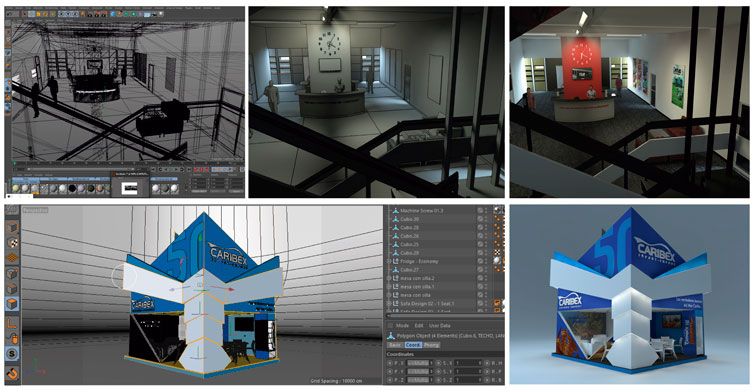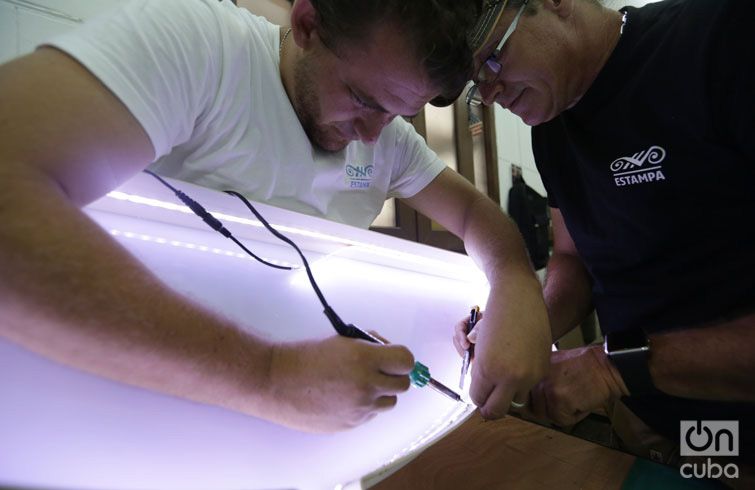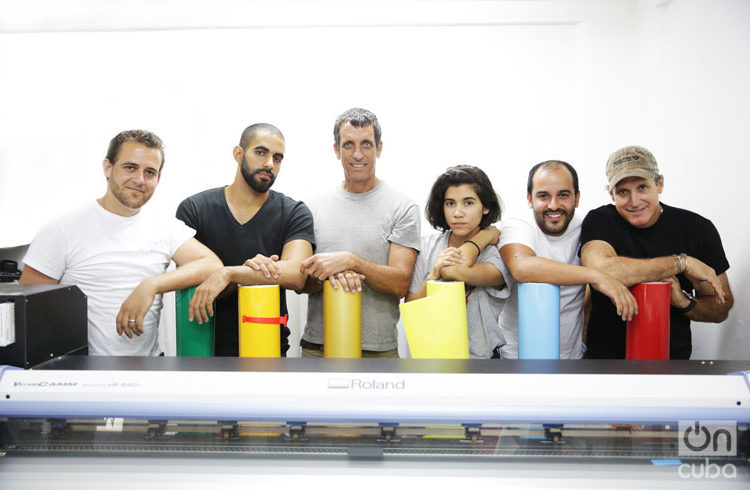In two years the Habana Estampa design workshop has transformed diverse spaces of the Cuban capital. The design workshop has worked with dissimilar clients, from renowned artists like Italian Michelangelo Pistoletto to diverse installations in the rooms of the Museum of Fine Arts.
“We work to create what the client likes, to create what doesn’t exist. When we are asked for something new, even if it is difficult, we say ‘yes, we can do it,’” affirms Alfredo Rosales Díaz, founder and leader of Habana Estampa.
Giving the client the most exact representation as possible of his/her idea – from a pencil case to a light box – is the premise of this workshop, located in Havana’s El Vedado, very close to the centric 23rd Street.
While the big industry produces en mass, in the Havana workshops the clients can create – with the help of the specialists -, a product just as he/she thought of. “We are competitive in small amounts and the industries in large amounts. Here we work at the level of specific clients with a more personalized treatment. You can come to make any prototype and create things your way, with the measures and colors you dreamed of,” he explains.
Alfredo Rosales Díaz is an architect and a painter who graduated from the San Alejandro Academy, which could explain the workshop’s proximity to numerous artistic projects. With the creation of Habana Estampa in 2015 he grouped around him young people from different parts to make up a team that doesn’t shy away from challenges.

Havana Estampa’s imprint can be found in the Neptuno-Tritón Hotel, in many private businesses in Cuba, in state-run enterprises or with renowned U.S. photographer Peter Turnley. With materials like PVC, wood, acrylic, impressions in vinyl, stationary, or made from acrylic, persons will have what they want.
“We are a workshop where we like to make new things. That’s why we seek the way to materialize any project, from making a piece of furniture with plasterboard and electrifying it, painting an interior, to making a base for an ashtray,” says Rosales Díaz.
Habana Estampa is young. But in its two years it has already more than 30 typified products, in photo exhibitions, window cases, microscope slides or wall clocks. In addition to those of which one or two have been produced as part of a very specific exclusive order.
In the world of fairs, like in the Habano Festival, or in the transformations of exhibition spaces, the 10-person team mutates. Each one of their professions merges in the constant hustle and bustle to achieve the results.
What most motivates are the challenges, the constant innovation, underlines Pedro Pablo Hernández Pérez, an Industrial Design graduate. That’s why he remembers when they hung 250 clay bricks from the roof of the Museum of Fine Arts. In the workshop they enjoy the orders to transform an exhibition room, from carrying out the museum project to conceiving the colors of the interior walls and the music.
The premise is to satisfy even the apparently simplest desires. This occurred with a person who ordered 10 jigsaw puzzles, an order that other workshops denied. Today she is one of the most faithful clients.

Habana Estampa is conceived as a school of creation more than a mere producing workshop. That’s why Alfredo and Pedro have been joined by Mario Armando and Heidi Rosa, Visual Communication graduates, for whom the productive world developed in them the instinct that the academy could not.
“We combine several focuses within the group: the architect, the industrial designer, the informational designer and the producer. They are all assets that contribute and no one is above anyone because we are a team,” Alfredo specifies.
The image and conception of Cuban establishments changed in recent years. The Cuban entrepreneurial sector has grown rapidly. The state-run enterprises have also started transforming their communication matrix to become competitive in the market. In that context, design has found fertile ground to develop and, at the same time, face challenges. “The workshops are places where someone must be able to resolve their problems thanks to the communion of knowledge, technology and creation,” affirms Rosales Díaz.
“The image of the places changes and with it quality also increases. The change of image has an influence on the retina and on the education of persons. Design in Cuba has speeded up, has more possibilities of expressing itself and is gaining in taste and personalization. It develops together with the social processes and the people are already oriented about where to go if they want to resolve something. It has increasingly inserted itself in the social dynamics and has become more personalized and human. The design places are as close and common as those where the pictures for 15th birthdays and weddings are taken,” says Alfredo.
Because of that closeness to clients, dozens of people request the services of the Havana workshop. For them it is common to assume between 8 and 10 orders simultaneously, some of them of great magnitude, like the design of a museum project for the Institute of Geology and Paleontology.
The reason for the workshop’s name was the inevitable question that Alfredo had to answer. “I didn’t give it the name, but I like Havana, the city where I live. And as to Estampa, it’s because of the desire to stamp an imprint, an imprint of our passage through reality. Be it from minor levels like creating a brand to a tridimensional product.” That is what Habana Estampa leaves: an imprint in the heritage of design, in the Cuba that is transforming.
Habana Estampa
Calle 27, número 901, esquina a 4, El Vedado, La Habana
habanaestampa@gmail.com
+(53) 7 835 16 75










